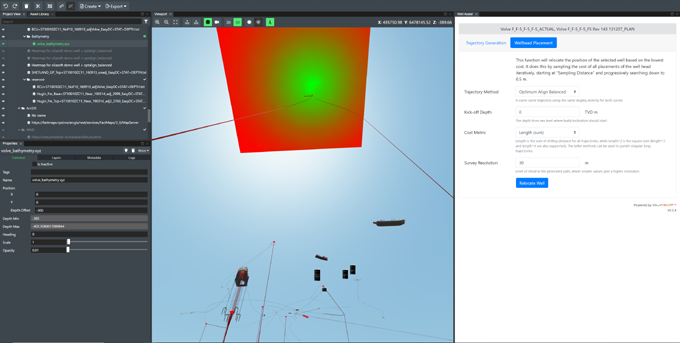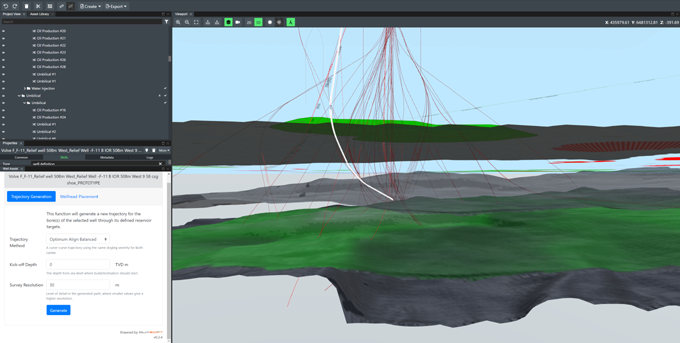FutureOn, the global software company and digital twin pioneer, has partnered with the cloud-based well planning company, Oliasoft, to launch a new software offering designed to disrupt business as usual across the oil and gas industry, and revolutionise subsea planning.
The new integrated solution, Well Assist, provides field planners and drilling engineers with a unique mix of capability, flexibility and insight from the earliest stages of feasibility studies, through to detailed subsea design, and into production.
The result is a data-rich, dependable and interactive approach to well planning that maximises cost efficiencies and collaboration while reducing risks, and enabling the fastest and most economic path to first oil.
The tool combines FutureOn's next-generation digital twin technologies, including FieldTwin Design 6.0, which bring real-time 3D planning into play from the earliest stages of project feasibility, with Oliasoft's proven engineering software, which is designed to seamlessly connect every link in the well planning calculation chain.
The integrated tool is fully compliant with industry standards and offers the ability to design, visualise, test and accurately cost field concepts from the topside to the target zone via a real-life, immersive subsea experience – all on desktop.
Well Assist gives engineers and planners complete control over each step of the field planning and well design journey by providing an information-rich geospatial environment that reflects GIS mapping data, bathymetry and existing infrastructure.
The picture is further enriched by proprietary information such as reservoir data, well data and drilling specifics – as well as associated metadata – to create meaningful, interactive 3D visualization of any potential project including its reach deep beneath the seafloor.
Jostein Lien, Senior Vice President of Products at FutureOn, said:
“By leveraging the building blocks of subsea design, specific coordinates, incline and azimuth – with the power of digital twin technology and industry-specific algorithms, Well Assist offers an unprecedented level of capability for field planners and drilling engineers.
“The software creates an accurate, interactive and tangible visualisation of subsea infrastructure, offering immediate insight into well design options and enabling better decision-making at the earliest stage.”

Features, which can be enhanced by asset operator input and tailored to specific project requirements, include:
- High-level algorithms – Well Assist has integrated a series of recognised mathematical methodologies that deploy increased levels of intelligent automation to create the optimum well path. The feature reflects subsea models regularly used by drillers, and the capabilities of existing tools, and is based on documented standards that support and build on directional drilling primitives.

The result is full point-to-point design capability, even across complex geologies, with a higher degree of sophistication at the earliest stage;
- Well-head placement – Well Assist can guide the ideal placement of well heads by generating a heat map based on factors including the cost metric. The feature can be used to compare the economics of various solutions based on the economics of a series of wells reaching specific targets.
Factors including length, the relationship between wells in a cluster, casing designs and sections lengths can identify the true optimal. The capability can be scaled to field-level manipulation of multiple well heads, each with a number of wellbores, allowing the business to determine the best way forward based on a range of requirements;
- Bespoke data sets – Because no two fields are exactly the same, and no two operators work in the exact same way, Well Assist is built to reflect the specific needs and traditions of the industry. Big data provides a wealth of options to create user-specific modelling based on operational requirements.
A crowded field for instance, may require the calculation of realistic separation factors based on 3D locations mapped within a deep borehole, where safety margins need to be increased.

Jostein concluded,
“Well Assist is ultimately about control over field design from topside to target, over timelines from concept to first oil, over economics from initial investment, through to operations and decommissioning. It will revolutionise field planning and well design by providing sophisticated and proven insight at the earliest stages of any subsea project. In a time of tight margins and increased competition, that is an advantage that no operator can afford to ignore.”
KeyFacts Energy Industry Directory: FutureOn
 KEYFACT Energy
KEYFACT Energy